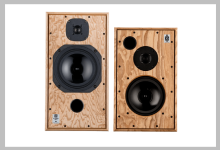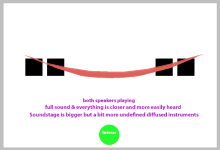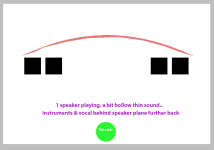I decided to ask since i really like what im hearing and would like to understand what makes this type of sound and build something like this in future:
--(images added)--
-Storytime: While ago i was listening for different kind of standmount speakers on different dealers.
I did ask to hear between two harbeth speakers they had in store, monitor 30.2 and c7es-3.
This store had system with rotel amplifier that had both speakers connected at the same time and, you could switch between two of them with A/B switch on remote.
I switched between them and they were ok for my taste, but after a while i suddenly heard a weird thing when i switched.
Volume was too high suddenly, so i turned it back down but behold:
This really perplexed me, suddenly sound was really so much better.
Instruments size and vocal were so much bigger, they were closer to me and sound had weight, body & more relaxed and presence. Everything was easier to hear, more clear, soundstage was bigger but also more diffused, not so easily localised. If single speaker was like 6-7 in scale to 10, suddenly sound was solid 9.
What had happened was that this amplifier could play both A and B at same time, and suddenly both speaker were playing same time.
------------------------------------------------------------------------------------------------------------------------------------------------
-My question is, what do you think made this difference?
Was it bigger area cm² of midwoofer & bass?
Was it placement, two midwoofers playing side by side? (wide baffle & "virtual" large midrange?)
-Can it be replicated with big single midrange driver?
(no comb filtering)

--(images added)--
-Storytime: While ago i was listening for different kind of standmount speakers on different dealers.
I did ask to hear between two harbeth speakers they had in store, monitor 30.2 and c7es-3.
This store had system with rotel amplifier that had both speakers connected at the same time and, you could switch between two of them with A/B switch on remote.
I switched between them and they were ok for my taste, but after a while i suddenly heard a weird thing when i switched.
Volume was too high suddenly, so i turned it back down but behold:
This really perplexed me, suddenly sound was really so much better.
Instruments size and vocal were so much bigger, they were closer to me and sound had weight, body & more relaxed and presence. Everything was easier to hear, more clear, soundstage was bigger but also more diffused, not so easily localised. If single speaker was like 6-7 in scale to 10, suddenly sound was solid 9.
What had happened was that this amplifier could play both A and B at same time, and suddenly both speaker were playing same time.
------------------------------------------------------------------------------------------------------------------------------------------------
-My question is, what do you think made this difference?
Was it bigger area cm² of midwoofer & bass?
Was it placement, two midwoofers playing side by side? (wide baffle & "virtual" large midrange?)
-Can it be replicated with big single midrange driver?
(no comb filtering)
Attachments
What amp was this? I don't think this was a good audition cause of the uncertainty of what the amp is doing and the dubious level matching.
Old fashioned way is best. Tell them to use a different amp and get the sales person to switch out the cables when you tell them to.
Old fashioned way is best. Tell them to use a different amp and get the sales person to switch out the cables when you tell them to.
Yes, level matching was off because this was impromtu, (no decibel meter) BUT i did also try to listen again 1 speaker vs 2 speakers and matched level with as. good as i could with ear. repeated many times.
Same result.
I also tried with lover volume for 2 speakers and louder for 1 speaker. (because people prefer louder statistically)
Same result.
Btw: What do you mean what amp was doing? Should there be a reason to suspect amplifier did something fundamentally different when playing both of them together?
Same result.
I also tried with lover volume for 2 speakers and louder for 1 speaker. (because people prefer louder statistically)
Same result.
Btw: What do you mean what amp was doing? Should there be a reason to suspect amplifier did something fundamentally different when playing both of them together?
Last edited:
I don't know anything about this amp (topology, circuitry, what happens to its output when running A+B with two different pairs of speakers.What do you mean what amp was doing? Should there be a reason to suspect amplifier did something fundamentally different when playing both of them together?
No reason to think it is dodgy, but this is not a clean way to compare speaker A vs B.
Also, who knows what is happening acoustically in that listening room when using all 4 speakers in whatever position they were placed; maybe it's some kind of reverb effect due to changed directivity and reflections that sound pleasing.
Makes me wonder if the remote's sending weak and/or slightly incorrect signals sometimes like my HT receiver remote does when the battery(ies) becomes weak.Yes A/B on remote
It's interesting to speculate that you were hearing a virtual wide baffle. Potentially a smoother/cleaner response in the lower midrange.
I was trying to choose which speakers to keep one time and had to keep both sets cause sounded better together. I think its common that two sets of speakers playing at the same time sounds better. Not as correct but better. Now I have another set, but only one.
Maybe if one set is very superior to the other it will sound best, but Im actually not sure😊.
I cant tell you what is going on.Maybe what Allen suggests?
Cheers!
Maybe if one set is very superior to the other it will sound best, but Im actually not sure😊.
I cant tell you what is going on.Maybe what Allen suggests?
Cheers!
Because I have an amp that easily drives 2 ohms and numerous speakers, I have on many occasions
driven multiple speakers together. I have found that positioning plays a huge part in any favorable synergy.
However, it is possible to 'fluke' a truly impressive result. I think Allen's point is very valid.
Mathematically, (ignoring comb filtering) if you averaged the frequency response of 200 good speakers
you would likely end up with a very flat / impressive result.
You can also achieve a very large/open soundscape that for many is very impressive.
driven multiple speakers together. I have found that positioning plays a huge part in any favorable synergy.
However, it is possible to 'fluke' a truly impressive result. I think Allen's point is very valid.
Mathematically, (ignoring comb filtering) if you averaged the frequency response of 200 good speakers
you would likely end up with a very flat / impressive result.
You can also achieve a very large/open soundscape that for many is very impressive.
Yeah, way back when Altec, Bozak, etc., were sold in HIFI emporiums with smaller and/or cheaper speakers in my locale they would feed the others with a lower level of the same demo for the big speakers to add ambiance, etc., in the usually too small space for the big horns, etc., to 'strut their stuff' 😉.
That is interesting. Yes i really liked that open full soundscape.Because I have an amp that easily drives 2 ohms and numerous speakers, I have on many occasions
driven multiple speakers together. I have found that positioning plays a huge part in any favorable synergy.
However, it is possible to 'fluke' a truly impressive result. I think Allen's point is very valid.
Mathematically, (ignoring comb filtering) if you averaged the frequency response of 200 good speakers
you would likely end up with a very flat / impressive result.
You can also achieve a very large/open soundscape that for many is very impressive.
One thing that came to my mind is that distortion is probably down since both woofers/tweeters have to work only half as hard to have same DB level (as single speaker).
One thing i could try is to do more tests, i think i could buy extra pair of wharfedale standmount speakers (they are cheap used) and run tests at home.
Im interested to see, what could be the end of road for this kind of experiment. What kind of speaker could optimise best possible sides of this kind of arrangement..
Hi, yeah interesting. Directivity would increase on low mids, where transducers at suitable distance apart compared to wavelength. Highs as well but the transducers are so far apart its just a mess of interference, which surely sound spacious but any clarity is gone I think.
If you start testing it, try if you can have the similar sound with single speaker by going closer to speakers. This should reduce importance of directivity for instance, and change quality of stereo image. Topend would not have the interference though, not sure if its good or bad regarding what you heard and liked about.
It would be interesting if you can say exactly what did you like about the sound, and how that actually happens/happened in the occasion 🙂 Will follow how ot turns out.
ps. check out Polk SDA speakers, which is essentially your setup, except with additional tricks how it's all hooked up electrically.
If you start testing it, try if you can have the similar sound with single speaker by going closer to speakers. This should reduce importance of directivity for instance, and change quality of stereo image. Topend would not have the interference though, not sure if its good or bad regarding what you heard and liked about.
It would be interesting if you can say exactly what did you like about the sound, and how that actually happens/happened in the occasion 🙂 Will follow how ot turns out.
ps. check out Polk SDA speakers, which is essentially your setup, except with additional tricks how it's all hooked up electrically.
And homes -this was one of the variations that was played with in the ambiance-extraction sector of quadraphonics. A very specific version was (AFAIK) actually the first time the term 'biamping' was significantly used, albeit in a completely different approach to what's usually described that way. Twin stereo amplifiers, with twin stereo speakers. The secondary set was positioned in an anteroom / chamber behind the main set, with partition walls between the systems approximately 1/2 the width of the room. Both fed the same signal of course. Allegedly the original system worked very well -no idea if anybody else ever tried it though, since it needed a fairly specific room construction. Plenty did a version of width stereo as GM described though, with additional L+R speakers at a wider angle fed the same signal at a lower amplitude. Can work surprisingly well on some material. I prefer difference signal extraction after Hafler, Gerzon etc. myself when I fire up a passive quad system, but it's an interesting one to play with. Real key for best results in any given application of these though is the ability to independently adjust the levels of the additional speakers / channels, so best with their own amplifier.OH the 'tricks' of a HiFi shop 😉
Edit: oddly enough, I still own, after about 23 years, a Rotel RA931 integrated. Just a £150 job from the late '90s, & currently in my store due to lack of space. Good little amplifier for the money though as it was a classic 'switch on & it works' design. Like the above it had exactly this A/B switching to the second pair of binding posts (albeit sans remote control) and I used it for a few years for driving a Hafler setup which I could switch on or off as desired.
Last edited:
Just doubling the level in any test will make everything sound much better - louder always scores higher until it starts to be painful, which is why its very important to level-match accurately with double-blind A/B testing.
And I suggest the reason louder scores higher is that more detail is audible as the various components of the sound rise up against the Fletcher-Munson curves and reveal more of themselves, and the pleasure centre responds to the louder bass (there's apparently a direct connection hard-wired http://cogweb.ucla.edu/ep/Sacculus.html)
And I suggest the reason louder scores higher is that more detail is audible as the various components of the sound rise up against the Fletcher-Munson curves and reveal more of themselves, and the pleasure centre responds to the louder bass (there's apparently a direct connection hard-wired http://cogweb.ucla.edu/ep/Sacculus.html)
I think this goes beyond loudness curves, the volume was not doubled but matched back down with ear.
I also tried lower volume for 2 speaker system and louder for 1 speaker when doing comparison, result was same.
I should have preferred 1 speaker playing louder but i didn't, presentation was same as before.
I also tried lower volume for 2 speaker system and louder for 1 speaker when doing comparison, result was same.
I should have preferred 1 speaker playing louder but i didn't, presentation was same as before.
I have always liked closefield listening in a room compared to farfield listening, room plays less part in this way.Hi, yeah interesting. Directivity would increase on low mids, where transducers at suitable distance apart compared to wavelength. Highs as well but the transducers are so far apart its just a mess of interference, which surely sound spacious but any clarity is gone I think.
If you start testing it, try if you can have the similar sound with single speaker by going closer to speakers. This should reduce importance of directivity for instance, and change quality of stereo image. Topend would not have the interference though, not sure if its good or bad regarding what you heard and liked about.
Interestingly clarity was not that much affected going 2 speakers, but i will have to test it again subjectively and try to measure to be sure how much degration there is compared to point source. I will think about how i want to test this, definitely i will buy larger fullrange/midrange driver to test out against two smaller/single driver. Well see..
'Should'? Who says you should? This is home audio, not a dictatorship. Who cares what anybody else thinks if you like it -you're the one listening to it, and if it ticks the boxes you like, that's what matters.I think this goes beyond loudness curves, the volume was not doubled but matched back down with ear.
I also tried lower volume for 2 speaker system and louder for 1 speaker when doing comparison, result was same.
I should have preferred 1 speaker playing louder but i didn't, presentation was same as before.
Assuming the amplifier can handle it (and since it's a Rotel, it will be able to), you have a different set of conditions. You have double the LF cone area, so for a given SPL greater headroom & lower HD, a totally different set of polars, and a slightly different set of room interactions as well, even though from the picture they were relatively close together. All of which make audible differences, even if some aren't necessarily imediately 'obvious', especially if you don't know exactly what to look out for & are in an unfamiliar situation on top of that. But from your description, unfamiliar or not, you clearly heard the macro aspects regarding the polars / power response, HD / dynamic headroom, room behaviour etc.:
Instruments size and vocal were so much bigger, they were closer to me and sound had weight, body & more relaxed and presence. Everything was easier to hear, more clear, soundstage was bigger but also more diffused, not so easily localised.
Which are all more or less exactly what you'd expect from such a configuration. No mysteries here, we're right back to the quadraphonic / pre-quadraphonic enhanced stereo era with this & it's been fooled with in various ways since at least the 1960s -longer if we include cinemas in that, and in other ways by various hi-fi shops -especially the box-shifters who as GM points out used to set up a dozen or so in a row with various switching systems. A lot of these ideas or implementations, deliberate or accidental have to a point been lost / forgotten to the mainstream for various reasons, but they're there if you know where to look & some were actually quite effective. Not without their own compromises, but what isn't? 😉
Last edited:
- Home
- Loudspeakers
- Multi-Way
- Why did this "speaker" sound this way? Pictures included...


